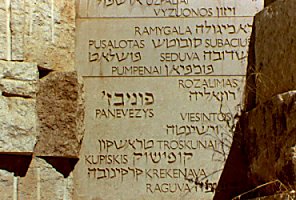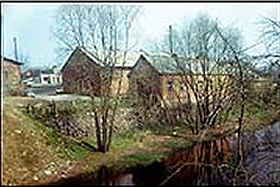Yad Vashem Testimony |
|
Ghetto area during the World War II, near the Kupe river. Jews arrested by the Nazis were kept in the smaller house in the foreground. During the Soviet period. they were used as warehouses of a local cooperative. The photo was taken in 1983. (Photo courtesy Boris Feldblyum Collection) |
|
 |
Valley of the Destroyed Communities at Yad Vashem (photo courtesy of Ada Greenblatt)
|
![]()
PAGES OF TESTIMONY FROM YAD VASHEMby M. Traub and D. Fleishman-Traub, Tel-AvivKupishuk - located in the forest on the river Kupe, 40 kilometers east of the capital of Ponevez. As the onset of the Holocaust, there were 1,500 Jews living there. The German army captured the town on June 26, 1941, when it was inhabited by many Jews who came there by foot from Ponevez, Subich and Vishinto. Many Jews also came there by horse and buggy. Shortly, the atrocities began. The Jews were put into ghettos and were given inadequate housing on Vilna Street. They lived in the old fire department headquarters where they were crowded and living conditions were unbelievable. They were given almost no food or water. Immediately, large groups were taken out to be slaughtered. The actual work was done by Lithuanian activists who were residents of Kupishuk before the German occupation. The Germans appointed a German resident named Luva as commander of the town. He came to Kupishuk during the Russian occupation claiming he was wounded by the Germans. The Russians took pity on him and made him a teacher in a gymnasia and he won their trust by posing as a Communist. Later, it became clear that he was a Nazi. According to his records, he arrested 25 people, kept them in a cellar, and in July, took them out behind the railroad station and killed them. The next group of Jews he arrested was larger and consisted of most males and a few younger women. He took all 41 of them on August, 1941, to the rear of the monastery and killed some. The rest he killed behind the Lithuanian gymnasia. He killed a third group in a similar manner. This was all done by Lithuanians under Luva's supervision. The intelligentzia of the city also have blood on their hands. The head of the police, P. Graizunas and his assistant, V. Gadialis, along with the gym teacher Kargzdieta, and Luva's lover, Zikunis, took part in this. Along with them, were graduates of the Lithuanian gymnasia including: Yukanis, Tchumshumis, Dubrindis, Dambraukartis and others, who helped uproot Jews from their hiding places. By September, 1941, not one Jew remained in Kupishuk. Among the 3,000 Jews killed were some from Vishinta, Shmantze, Plivna, and some from Subech and othe small communities. There was a priest named Ragouskas who was a teacher in the Kupishuk gymnasia. He was disenchanted with Catholicism and tried to save some Jews, but it was in vain since Luva and his followers found them. Dr. J. Franzkevich was the doctor in Kupishuk and tried to save the Rebbetzin Pertzovsky and Mrs. Meyerovitz and her children, but they were killed. One of the first young Jews to revolt was I. Gershumet. Along with him was: Ch. Yutin, H. Shoistevnia, Tzundel, and their friends. They revolted against their Lithuanian students who aided the Nazis. They wounded 2 students which caused even more hatred towards the Jews. Only 3 Jewish cemeteries remained in Kupishuk. One behind Casa Caten, one near the seminary and a small one near the railroad station. The Jews who tried to escape were killed along with the others. Very few succeeded in reaching Russia and few remained in the Vilna or Kovna ghettos. After the War, the Kupishuker survivors organized and built a monument for the fallen, written in Lithuanian, Russian and Yiddish. They wanted to erect this monument where the Kupishukers were killed, but the Russian government wouldn't allow it and the monument was kept in an office until 1953 when it was moved elsewhere. On it was inscribed "Casualties of the Facists in Russian and Lithuanian. In the cemetery logbook titled, "The Slaughter of the Public in Lithuania", it reveals 3 places of murder in Kupishuk. The first place is at the end of Gidamin Street in Kupishuk, near the priests' cemetery. The date of the slaughter was late in 1941 and about 1,000 people were killed. The second place is near the Jewish cemetery on the River Kupe where, late in 1941, 2,700 people were killed. The third is the Slavantziskis forest, 1 kilometer from the railroad station toward Shimyana. The date is June 28, 1941, and 78 people were killed. |
